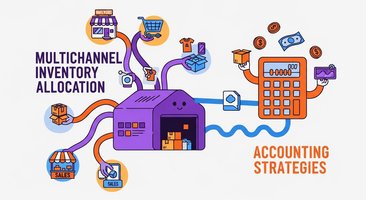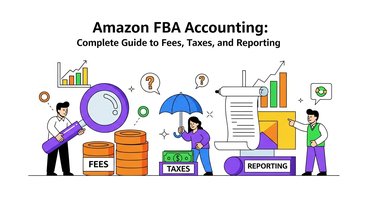Walmart Marketplace accounting requires specialized approaches that navigate unique fee structures and operational requirements while maintaining accurate profitability analysis and compliance standards. Successful Walmart sellers achieve 28% better margin visibility, improved inventory optimization, and enhanced competitive positioning compared to those using generic marketplace accounting methods.
Yet 71% of Walmart Marketplace sellers struggle with accurate fee tracking and performance analysis, leading to pricing errors and missed optimization opportunities worth an average of $22,000 annually in lost profits and strategic insights.
The complexity of Walmart's marketplace ecosystem stems from its focus on value positioning, strict quality standards, and operational excellence requirements that differ significantly from other marketplace platforms. Fulfillment options, advertising costs, and performance metrics all impact profitability in ways that require specialized understanding and tracking.
The Walmart Marketplace Challenge:
Walmart's emphasis on everyday low prices and customer value creates competitive pressure that requires precise cost management and margin optimization to maintain profitability. Quality standards and performance requirements are more stringent than many other marketplaces, affecting operational costs and seller sustainability.
Fulfillment Services including Walmart Fulfillment Services (WFS) create additional fee categories and operational considerations that impact cost structures and customer experience delivery. Advertising opportunities through Walmart Connect require different strategies and measurement approaches than other marketplace advertising platforms.
Pro Seller requirements and growth expectations create ongoing investment needs that must be balanced against profitability targets and competitive positioning within Walmart's value-focused marketplace environment.
This comprehensive guide reveals proven strategies for mastering Walmart Marketplace accounting, optimizing seller performance, and leveraging platforms like Klavena's Walmart integration to maintain accuracy while maximizing profitability and operational excellence.
Understanding Walmart Marketplace Fee Structure
Walmart Marketplace fee structure reflects the platform's focus on value and operational efficiency while providing sellers with competitive opportunities in the growing online marketplace environment.
Core Fee Categories:
Referral fees on Walmart Marketplace are generally lower than other major platforms, ranging from 6% to 15% depending on product category, reflecting Walmart's commitment to supporting seller profitability and competitive pricing. Category-specific rates vary based on product type and market dynamics within Walmart's ecosystem.
Professional seller fees are not charged monthly like some platforms, but sellers must meet Pro Seller requirements including performance standards and operational capabilities that may require investment in systems and processes. Volume commitments and growth expectations may affect seller standing and marketplace opportunities.
Fulfillment Services fees for Walmart Fulfillment Services (WFS) include storage, picking, packing, and shipping costs that vary by product size, weight, and seasonal demand patterns. Returns processing and customer service are included in WFS fees but affect overall cost structure and profitability calculations.
Additional Service Fees:
Walmart Connect advertising fees are charged based on advertising performance and campaign effectiveness, requiring careful tracking and ROI analysis for optimization. Sponsored product and display advertising options provide visibility but add to overall selling costs.
Premium placement and enhanced content opportunities may be available for qualifying sellers but require additional investment and performance analysis. International expansion through Walmart's global initiatives may involve additional fees and compliance requirements.
Seasonal adjustments and peak period surcharges may apply during high-demand periods, affecting cost structures and pricing strategies during critical selling seasons.
Inventory Management and Fulfillment Options
Walmart Marketplace inventory management requires understanding different fulfillment options and their impact on costs, customer experience, and competitive positioning within the platform ecosystem.
Fulfillment Strategy Comparison
Seller Fulfilled Prime (SFP):
Self-fulfillment allows maximum control over inventory, packaging, and shipping while requiring investment in operational capabilities and performance standards. Shipping requirements including delivery speed and tracking must meet Walmart's customer expectations and performance metrics.
Cost structure for self-fulfillment includes warehousing, labor, packaging materials, and shipping costs that must be tracked and allocated appropriately for profitability analysis. Performance standards for delivery speed and accuracy affect seller metrics and marketplace standing.
Flexibility benefits include control over packaging, branding, and customer communication while maintaining responsibility for customer satisfaction and returns processing. Scalability considerations require planning for peak periods and growth without compromising performance standards.
Walmart Fulfillment Services (WFS):
Full-service fulfillment through WFS provides professional logistics capabilities while transferring inventory control and customer interaction to Walmart's systems. Storage fees vary by product size and seasonal demand patterns, requiring careful inventory planning and cost analysis.
Pick and pack fees are calculated per shipment and vary by product characteristics and packaging requirements. Shipping costs are included but may be higher than negotiated rates available to large-volume shippers using alternative fulfillment methods.
Customer service and returns processing are handled by Walmart's teams, reducing seller operational burden while limiting direct customer relationship management opportunities. Inventory visibility and control may be reduced compared to self-fulfillment options.
Inventory Planning and Optimization
Demand Forecasting:
Walmart-specific demand patterns may differ from other marketplaces due to customer demographics and shopping behavior characteristics unique to the platform. Seasonal trends and promotional periods require careful planning to optimize inventory levels and avoid stockouts or overstock situations.
Geographic distribution considerations affect inventory positioning and fulfillment speed, particularly for sellers using multiple fulfillment centers or WFS locations. Competitive analysis within Walmart's marketplace helps predict demand and optimize inventory investment decisions.
Product lifecycle management considers Walmart's focus on value and customer satisfaction when making decisions about product launches, promotions, and discontinuations.
Cost Optimization:
Storage cost management requires balancing inventory levels with carrying costs and seasonal demand patterns, particularly for sellers using WFS services. Inventory turnover optimization reduces carrying costs while maintaining service levels and customer satisfaction.
Obsolescence management and liquidation strategies minimize losses from slow-moving or discontinued inventory while maintaining seller performance metrics. Supplier relationships and purchasing strategies optimize product costs while ensuring quality standards that meet Walmart's requirements.
Performance Standards and Compliance
Walmart Marketplace maintains strict performance standards that affect seller standing, marketplace opportunities, and long-term success within the platform ecosystem.
Seller Performance Metrics
Order Defect Rate (ODR):
Quality standards for order fulfillment including accuracy, completeness, and condition must be maintained below threshold levels to avoid performance issues. Defect tracking and root cause analysis help identify improvement opportunities and prevent performance degradation.
Customer feedback and return rates contribute to ODR calculations and require systematic monitoring and improvement efforts. Packaging quality and product condition affect customer satisfaction and performance metrics.
Process improvement and quality control procedures help maintain performance standards while scaling operations and managing growth effectively.
On-Time Delivery:
Shipping performance standards require consistent delivery within promised timeframes regardless of fulfillment method chosen. Carrier performance and shipping method selection affect delivery success rates and customer satisfaction metrics.
Peak period planning ensures adequate capacity and performance during high-demand seasons when delivery challenges typically increase. Backup plans and contingency procedures help maintain performance when primary fulfillment methods experience issues.
Communication standards with customers about shipping delays or issues help maintain satisfaction even when delivery problems occur.
Compliance Requirements
Product Standards:
Quality assurance and product safety requirements must be met consistently to maintain marketplace standing and avoid customer issues. Documentation requirements for product specifications and safety certifications may be more stringent than other platforms.
Brand authorization and intellectual property compliance prevent legal issues while ensuring legitimate product sourcing and sales. Restricted products and category requirements must be understood and followed to avoid account issues.
Labeling and packaging standards ensure products meet Walmart's requirements for customer experience and operational efficiency.
Operational Compliance:
Tax compliance including sales tax collection and remittance must be managed according to Walmart's requirements and jurisdictional obligations. Business registration and professional seller requirements must be maintained for continued marketplace access.
Data security and privacy compliance protect customer information while meeting Walmart's operational and legal requirements. Communication standards with customers and Walmart support teams must be maintained professionally and responsively.
Financial Reporting and Analysis
Walmart Marketplace financial reporting requires specialized approaches that capture platform-specific performance metrics while providing actionable insights for optimization and strategic decision-making.
Profitability Analysis
Product-Level Performance:
Comprehensive cost calculation includes all Walmart fees, fulfillment costs, and operational expenses to determine true product profitability within the marketplace environment. Category performance analysis reveals which product types perform best on Walmart and deserve increased investment and focus.
Competitive positioning analysis considers Walmart's value focus and price sensitivity when evaluating product performance and optimization opportunities. Margin analysis must account for Walmart's competitive environment and customer price expectations.
Volume vs. margin optimization balances sales growth with profitability targets while maintaining competitive positioning within Walmart's marketplace ecosystem.
Channel Comparison:
Walmart performance relative to other marketplaces reveals platform-specific strengths and optimization opportunities for resource allocation decisions. Customer behavior differences on Walmart may affect product mix and marketing strategies compared to other platforms.
Operational efficiency comparison across channels helps optimize fulfillment and operational strategies for maximum effectiveness and profitability. Growth potential analysis guides investment priorities and strategic focus across different marketplace opportunities.
Performance Metrics and KPIs
Sales Performance:
Revenue growth tracking identifies successful products and strategies worthy of expansion and increased investment within Walmart's marketplace. Market share analysis within specific categories reveals competitive positioning and growth opportunities.
Customer acquisition and repeat purchase rates provide insights into customer satisfaction and long-term business sustainability on the platform. Seasonal patterns and trend analysis help optimize inventory and marketing strategies throughout the year.
Conversion rate optimization identifies opportunities to improve product listings, pricing, and positioning for maximum sales effectiveness.
Operational Efficiency:
Cost per sale analysis includes all fees and operational costs to understand true transaction efficiency and profitability. Inventory turnover rates guide purchasing decisions and working capital optimization strategies.
Customer service efficiency and return processing costs affect overall profitability and customer satisfaction metrics. Fulfillment performance metrics including speed and accuracy impact customer satisfaction and seller standing.
Technology Integration and Automation
Modern Walmart Marketplace operations require sophisticated technology integration that provides automated data processing and comprehensive reporting while maintaining compliance and operational efficiency.
System Architecture
Walmart API Integration:
Real-time data synchronization with Walmart's systems ensures accurate inventory management and prevents overselling situations that could damage seller performance. Order processing automation streamlines fulfillment workflows while maintaining accuracy and speed requirements.
Performance monitoring integration provides immediate visibility into seller metrics and identifies issues before they affect marketplace standing. Inventory management automation prevents stockouts and overstock situations while optimizing working capital investment.
Reporting automation provides regular insights into sales performance, profitability, and optimization opportunities without manual data compilation efforts.
Multi-Channel Integration:
Inventory synchronization across Walmart and other sales channels prevents overselling while optimizing stock allocation based on channel performance and opportunities. Pricing coordination ensures competitive positioning across channels while maintaining profitability targets.
Customer data integration provides comprehensive customer insights when possible while respecting platform restrictions and privacy requirements. Performance comparison across channels guides resource allocation and strategic focus decisions.
Klavena's Walmart Integration
Comprehensive Marketplace Support:
Klavena provides seamless integration with Walmart Marketplace to capture all transaction details, fees, and performance metrics automatically. Real-time processing eliminates manual data entry while ensuring accuracy and completeness of financial information and analysis.
Automated fee tracking captures all Walmart charges including referral fees, fulfillment fees, and advertising costs for accurate profitability analysis. Multi-fulfillment support handles both self-fulfilled and WFS transactions with appropriate cost allocation and analysis.
Performance monitoring integration tracks seller metrics and identifies optimization opportunities for maintaining marketplace standing and growth. Inventory optimization features help balance carrying costs with service levels and sales opportunities.
Advanced Analytics:
Product profitability dashboards provide real-time insights into item performance including all associated costs and fees specific to Walmart's marketplace environment. Category analysis identifies which product types perform best on Walmart and deserve increased investment.
Competitive analysis tools help optimize pricing and positioning within Walmart's value-focused marketplace while maintaining profitability targets. Seasonal analysis capabilities identify patterns and optimization opportunities throughout the year.
Cash flow management features provide visibility into Walmart's payment schedules and help optimize working capital management for sustainable growth.
Strategic Optimization for Walmart Success
Walmart Marketplace success requires strategic approaches that align with the platform's value proposition while building sustainable competitive advantages and profitable growth.
Value Positioning Strategy
Price Competitiveness:
Cost optimization throughout operations enables competitive pricing while maintaining profitability targets within Walmart's value-focused environment. Efficiency improvements in sourcing, fulfillment, and operations support pricing advantages without sacrificing margins.
Value communication through product descriptions and enhanced content helps customers understand product benefits and quality that justify pricing decisions. Bundle strategies and cross-selling opportunities improve average order values while providing customer value.
Supplier relationships and purchasing power development enable better product costs that support competitive pricing and margin targets.
Quality and Service Excellence:
Product quality consistency meets Walmart's standards while supporting premium positioning within value-focused categories. Customer service excellence builds positive reviews and repeat business that support long-term success and growth.
Operational reliability including consistent delivery and accurate order fulfillment builds customer trust and supports positive seller metrics. Problem resolution capabilities handle issues quickly and professionally to maintain customer satisfaction and seller standing.
Growth Strategy Development
Category Expansion:
Market analysis identifies category opportunities that align with Walmart's customer base and value proposition while offering growth potential and profitability. Product development or sourcing strategies support expansion while maintaining quality and cost standards.
Performance tracking for new categories and products enables rapid optimization and resource allocation adjustments based on actual results. Risk management approaches minimize investment in unsuccessful expansions while maximizing successful growth opportunities.
Operational Scaling:
Fulfillment capacity planning ensures operations can handle growth without compromising performance standards or customer satisfaction. Technology investment supports scaling while maintaining operational efficiency and cost control.
Team development and process improvement enable growth while maintaining quality standards and operational excellence. Financial planning ensures adequate working capital and investment capacity for sustainable growth initiatives.
Implementation Best Practices
Successful Walmart Marketplace accounting implementation requires systematic approaches that address platform-specific requirements while building sustainable operational capabilities and competitive advantages.
Implementation Framework
Phase 1: Foundation Building (Months 1-2)
Platform assessment identifies Walmart-specific opportunities and requirements that align with business capabilities and strategic objectives. Compliance review ensures understanding of all performance standards and operational requirements for marketplace success.
Cost structure analysis identifies all fees and operational costs specific to Walmart Marketplace operations for accurate profitability analysis and pricing decisions. Technology integration planning establishes data flow and reporting capabilities for comprehensive performance management.
Performance baseline establishment provides benchmarks for measuring improvement and optimization success over time.
Phase 2: Operational Integration (Months 3-4)
System integration implementation provides real-time data synchronization and automated processing for efficient operations and accurate reporting. Process development creates standardized procedures for order fulfillment, customer service, and performance management.
Performance monitoring systems provide immediate visibility into seller metrics and optimization opportunities. Quality assurance procedures ensure consistent performance and customer satisfaction that meets Walmart's standards.
Team training ensures staff understand Walmart-specific requirements and can execute strategies effectively for marketplace success.
Phase 3: Optimization and Growth (Months 5-6)
Performance analysis identifies the most effective strategies and products for increased investment and strategic focus. Process optimization based on operational experience improves efficiency and customer satisfaction.
Growth planning identifies expansion opportunities and resource requirements for sustainable development within Walmart's marketplace ecosystem.
Success Factors
Critical Elements:
Value focus and operational excellence align with Walmart's marketplace philosophy while building sustainable competitive advantages and customer satisfaction. Performance consistency maintains seller standing and marketplace opportunities for long-term success.
Customer satisfaction priority ensures positive reviews and repeat business that support growth and profitability targets. Continuous improvement culture drives ongoing optimization and adaptation to changing marketplace requirements and opportunities.
Data-driven decision making based on comprehensive performance analysis ensures optimization efforts focus on the most impactful opportunities and strategies.
Common Pitfalls:
Inadequate cost tracking leads to pricing decisions that may not support profitability targets or competitive positioning within Walmart's value-focused environment. Performance standard neglect can result in seller standing issues that limit marketplace opportunities and growth potential.
Quality shortcuts that compromise customer satisfaction or product standards can damage seller reputation and long-term success on the platform. Insufficient differentiation in competitive categories may lead to price competition that erodes profitability and sustainability.
Conclusion and Strategic Recommendations
Walmart Marketplace accounting represents a specialized capability that enables sellers to succeed within one of the most demanding and value-focused ecommerce environments. The platform's emphasis on operational excellence and customer value creates both challenges and opportunities for sellers who master its requirements.
Strategic Value Creation:
Operational excellence and cost optimization enable competitive positioning while maintaining profitability within Walmart's value-focused marketplace environment. Performance consistency builds seller standing and marketplace opportunities that support long-term growth and success.
Customer satisfaction focus creates positive reviews and repeat business that drive sustainable competitive advantages and reduced customer acquisition costs. Data-driven optimization ensures continuous improvement and adaptation to changing marketplace dynamics and customer expectations.
Implementation Recommendations:
Prioritize operational excellence and performance standards to build strong seller standing and marketplace opportunities for sustainable growth. Invest in cost optimization and efficiency improvements that enable competitive pricing while maintaining profitability targets.
Focus on customer satisfaction and quality consistency to build positive reputation and long-term success within Walmart's marketplace ecosystem. Develop comprehensive tracking and analysis capabilities that provide insights needed for continuous optimization and strategic decision-making.
Plan for sustainable growth that balances expansion opportunities with operational capabilities and performance standard maintenance.
Klavena's Walmart Solution:
Klavena provides comprehensive Walmart Marketplace accounting that handles platform-specific requirements while providing optimization insights and performance tracking capabilities. The platform eliminates complexity while ensuring accuracy and compliance with Walmart's operational standards.
Getting Started:
Klavena makes Walmart Marketplace accounting implementation straightforward through specialized features for the platform, comprehensive integration capabilities, and ongoing optimization support that ensures sustainable competitive advantage and marketplace success.
Walmart Marketplace continues growing as a major ecommerce destination with increasing opportunities for sellers who meet its standards and value proposition. Start building advanced Walmart accounting capabilities today – the operational insights and competitive advantages create sustainable success that justifies immediate investment in professional Walmart Marketplace management and optimization systems.





